You’ll hike the red rocks, you’ll cool in the creek, and you’ll photograph views that stick with you—so bring sensible shoes and a camera. You’ll want practical tips on getting there, timing your visit, and which trails suit your energy level, plus the basic rules that keep the park safe and respected. Stick around for concise, usable advice that makes the most of your time at Slide Rock.
Getting There: Directions, Parking, and Best Routes
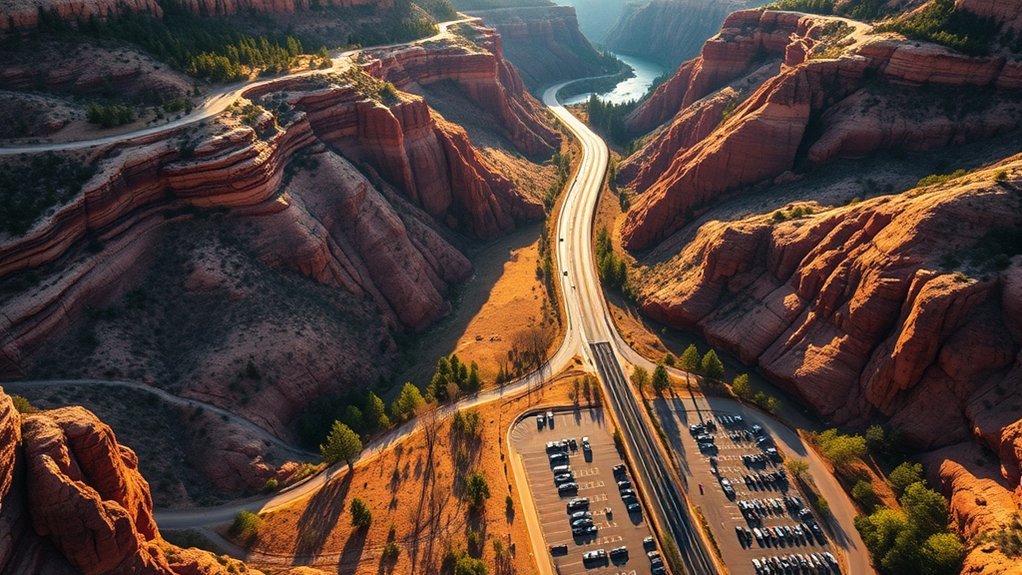
Start your drive early to beat crowds and the midday heat—Slide Rock State Park sits about 3 miles north of Sedona along scenic Highway 89A, and the approach winds through narrow red-rock canyons that hint at the park’s natural features. You’ll follow 89A from Sedona northbound; if you’re coming from Flagstaff, take I‑17 south to 179 then west onto 89A. Choose the best routes by checking traffic and shuttle options during peak season. When you arrive, scout parking options: the park’s lot fills fast, roadside spaces appear nearby, and private lots or shuttle parking in Uptown Sedona can save time. Watch posted signs, arrive prepared, and pack light for short walks to the creek.
Hours, Fees, and Reservations
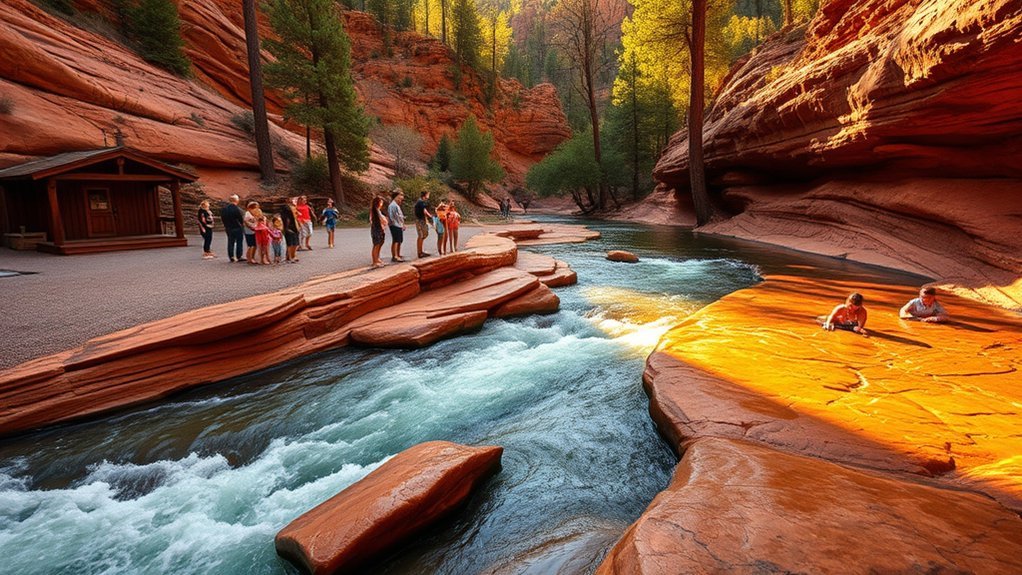
Check the park’s seasonal hours before you go, since summer days and cooler months have different opening times and visitor limits. You’ll pay a per-vehicle fee during peak season and may need a reservation or permit for large groups or special activities. Keep an eye on the state park website for current rates, reservation windows, and any temporary closures so you’re not surprised at the gate.
Park Hours & Seasons
Because seasons change the rhythm of the park, you’ll want to plan your visit around Slide Rock’s varying hours, entry fees, and reservation requirements; summer days bring long hours and crowds, while winter and shoulder seasons often mean reduced services and limited access. You’ll find the best visiting times in spring and fall—milder temperatures, thinner crowds, and active seasonal wildlife along the creek. Summer opens the park early and keeps facilities busy; expect peak crowds midday and a lively, noisy scene. Winter hours shorten, restrooms may close, and trails can be icy. Check the park’s official calendar before you go so you arrive when trails, parking, and visitor services match your comfort level and desired experience.
Fees, Permits & Reservations
While fees and permits vary by season and event, you’ll generally find a straightforward entry fee for vehicles and occasional requirements for timed reservations during peak summer weekends. You’ll pay the posted entry fees at the gate or use an online pass, and you should check for special permit requirements if you plan a commercial shoot, research project, or large group gathering. Signage and park staff will confirm details when you arrive.
- Vehicle entry fees: daily rates and annual pass options.
- Timed reservations: required on busy summer weekends.
- Special permit requirements: weddings, vendors, and research.
- Payment methods: cash, card, or online purchase.
- Refunds and cancellations: read reservation policies before booking.
What to Do: Swimming, Sliding, Hiking, and Photography
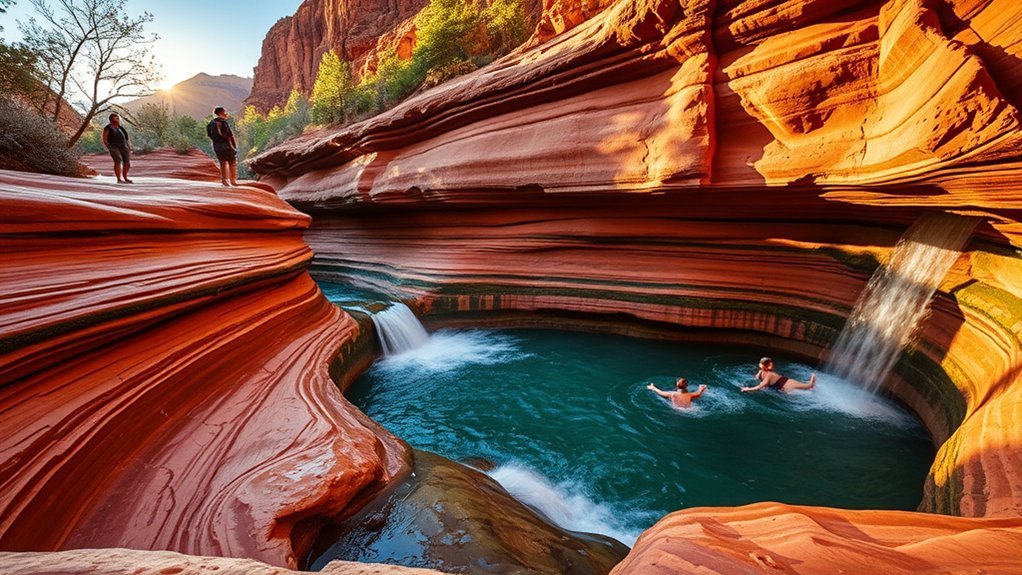
When you arrive at Slide Rock State Park, the Redline of Oak Creek calls you to move—wade into clear pools, ride natural water slides, lace up for cliffside trails, or lift your camera for canyon light that shifts by the minute. You’ll find river activities that suit both calm swims and playful sliding; slick red sandstone carves lanes where you can float, plunge, and laugh with friends. Trails climb to scenic viewpoints that frame the creek, orchards, and jagged rimrock, offering short walks or longer treks into red-rock intimacy. Bring water shoes for traction, a small pack for lenses and snacks, and eyes tuned to patterns of light on water and stone. Every turn offers a new composition—movement, texture, color—waiting for your frame.
Safety Tips and Park Rules
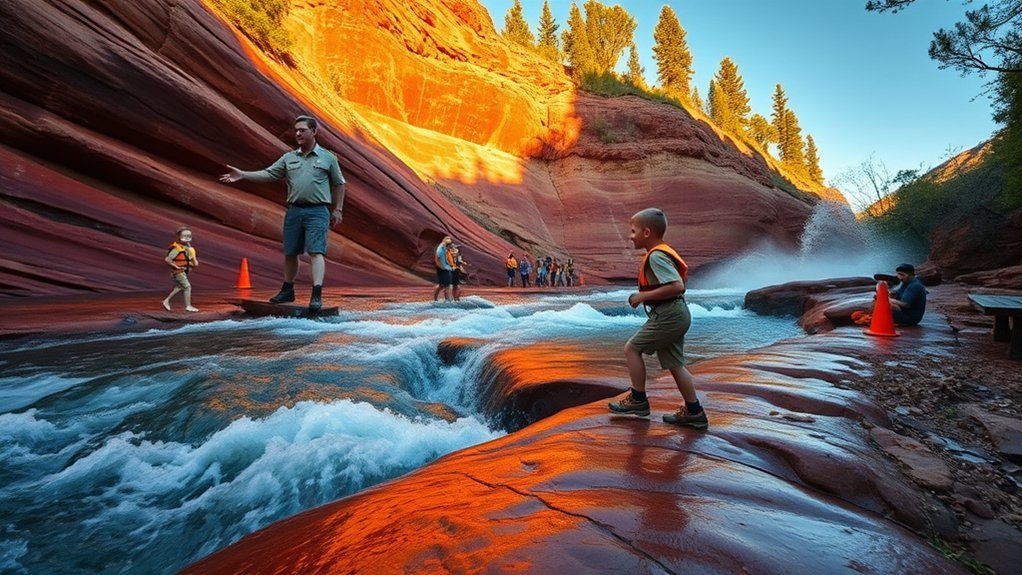
Though the creek invites play, Slide Rock State Park requires you to stay alert: follow posted rules, heed lifeguards or rangers, and respect seasonal closures so everyone stays safe. You’ll want to watch footing on slick rocks, control kids near currents, and keep a calm head if a wildlife encounters occurs—observe from distance and don’t feed animals. Learn emergency procedures posted at trailheads and note ranger contact points before you wander. Respect signage that limits access during high water or repairs.
- Keep to marked paths and guardrails; slippery surfaces are real.
- Supervise children and non-swimmers at all times.
- Don’t disturb wildlife; photograph from afar.
- Know park emergency procedures and nearest help locations.
- Pack out trash; leave no trace.
What to Pack and What to Wear
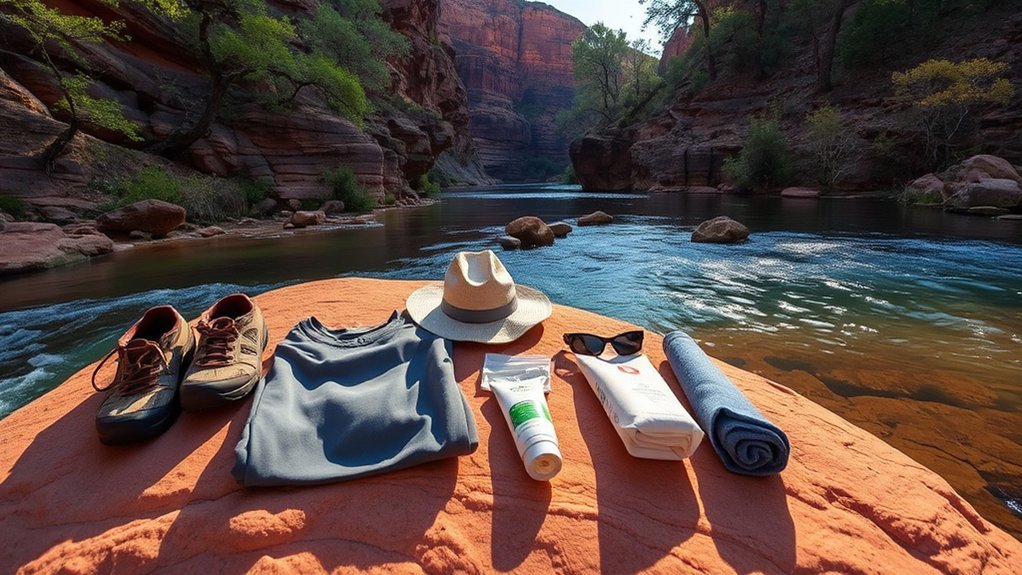
After you’ve noted the park’s safety rules and emergency points, plan your gear so you stay comfortable and secure outdoors. Bring packing essentials: plenty of water, a small first-aid kit, sunscreen, insect repellent, and a waterproof bag for phones and snacks. Pack sturdy water shoes with good grip for slippery rocks and a lightweight towel that dries quickly. For clothing recommendations, choose quick-dry layers — a moisture-wicking shirt, breathable shorts, and a light windbreaker for shade or breezy evenings. Don’t forget a wide-brim hat and polarized sunglasses to cut glare. If you’ll picnic, include a trash bag to pack out waste. Travel-light but deliberate: the right gear keeps your focus on the river’s beauty, not discomfort.
Nearby Attractions and Day-Trip Ideas
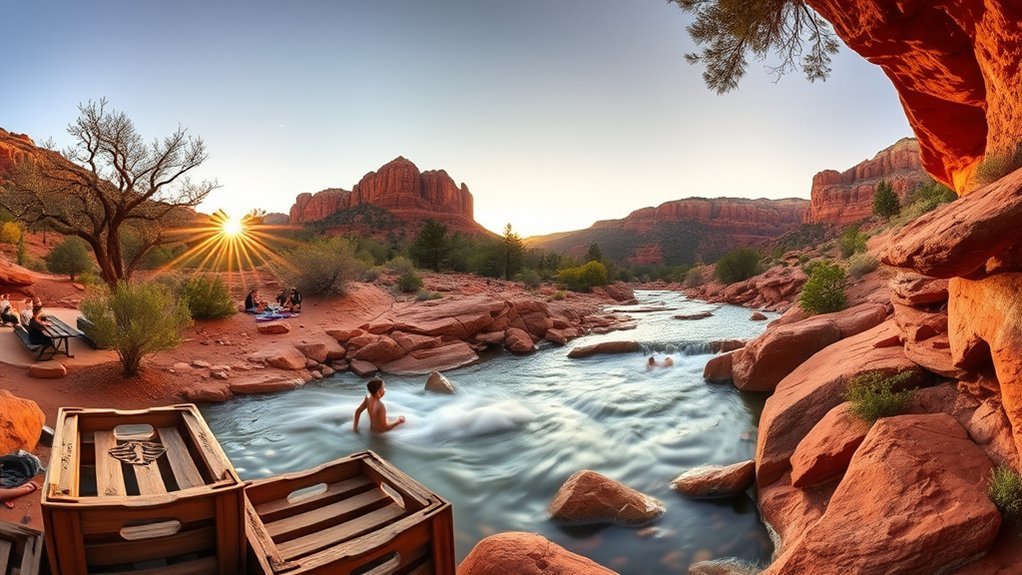
After you’ve had your fill at Slide Rock, you can head out to the Sedona Red Rock Loop for sweeping views of sandstone formations that glow at golden hour. A scenic drive through Oak Creek Canyon lets you spot waterfalls, picnic pullouts, and hush-of-the-pines overlooks along the way. If you like history, swing by nearby historic sites to walk old main streets, visit preserved homesteads, and trace the area’s frontier stories.
Sedona Red Rock Loop
If you’re looking to extend your Slide Rock day into a full Red Rock experience, the Sedona Red Rock Loop delivers dramatic vistas, winding roads, and easy access to iconic trails like Cathedral Rock and Bell Rock. You’ll notice Sedona geology everywhere: layered sandstone, striking buttes, and sculpted Red rock formations that glow at sunrise. Drive slowly, stop often, and let short hikes reveal slot canyons and panoramic overlooks. Plan for midday shade or golden-hour photos.
- Park at trailheads for Cathedral Rock, Bell Rock, and Courthouse Butte
- Walk short loops to view unique spires and bedding planes up close
- Bring water and sun protection for exposed ridgelines
- Time visits for sunrise or sunset light
- Respect fragile vegetation and private land boundaries
Oak Creek Canyon Drives
Leave the Sedona skyline behind for a scenic drive that winds you down into Oak Creek Canyon, a narrow gorge where towering red walls give way to cottonwoods, sycamores, and clear riffles of water. You’ll hug switchbacks, pause at scenic viewpoints that frame the creek below, and feel the temperature drop as shade deepens. Pull over where turnout signs promise brief hikes or river access; a short stroll reveals riffled pools and sun-dappled boulders. Keep your camera ready for wildlife spotting—rocky ledges often host lizards, songbirds, and mule deer at dawn or dusk. Drive slowly, respect posted closures, and plan to stop for a picnic; the canyon’s rhythm makes it easy to trade a fast trip for lingering moments of quiet and view.
Nearby Historic Sites
While you’re exploring Slide Rock, take time to visit the nearby historic sites that lace the landscape with stories—from pioneer settlements to old mining camps—each one offering a different window into the region’s past. You’ll find that historic landmarks nearby reveal layers of cultural heritage: preserved cabins, rusted equipment, and interpretive signs that let you trace daily life long ago. Walk quietly, imagine the routines of settlers, and photograph details that catch your eye. These sites make excellent day trips, giving context to the canyon’s natural beauty and connecting you to human stories etched into the rocks.
- Jerome Mine ruins — rugged remnants of mining history
- Old homestead cabins — weathered wood and stone foundations
- Historic schoolhouse — small, restored classroom
- Pioneer cemetery — silent, poignant markers
- Cultural heritage museum — artifacts and local narratives
Frequently Asked Questions
Are Pets Allowed in the Park Year-Round?
Yes — you can bring pets year-round, but you’ll follow pet policies and park regulations: keep pets leashed, clean up after them, and avoid restricted areas; you’ll respect wildlife and fellow visitors for a pleasant, safe visit.
Is There Cell Phone Service Inside the Park?
You won’t have reliable cell coverage everywhere; signal strength varies with location and crowding. You’ll find patches of service near parking and main facilities, but deeper trails and canyons often leave you offline, so plan accordingly.
Are There Picnic Table or Shelter Reservations Available?
By golly, yes — you can reserve some picnic facilities and check shelter availability online or by phone; you’ll enjoy shaded tables, scenic views, and cozy covered spots, so plan ahead to secure the best picnic experience.
Can I Bring a Drone to Fly Over the Park?
No, you can’t fly a drone there; park drone regulations prohibit unmanned aircraft, but you can enjoy scenic photography guidelines on trails and overlooks, capturing landscapes responsibly, respecting wildlife, other visitors, and posted rules for permitted camera use.
Is There a Lifeguard on Duty During Peak Season?
Once, I watched a parent scan like a lighthouse keeper — no, there isn’t consistent lifeguard availability; during peak season you’ll find limited coverage, so you’ll need to prioritize peak season safety and supervise children closely yourself.
Conclusion
You’ve got the map, the rules, and a plan — now go make memories. Like finding a secret chapter in a favorite book, Slide Rock’s red-rock slides, cool pools, and sun-dappled trails feel familiar and thrilling all at once. Stay safe, respect the land and cultures here, and bring water and good shoes. Whether you splash, hike, or just watch the light change on the rocks, you’ll leave richer for the visit.

